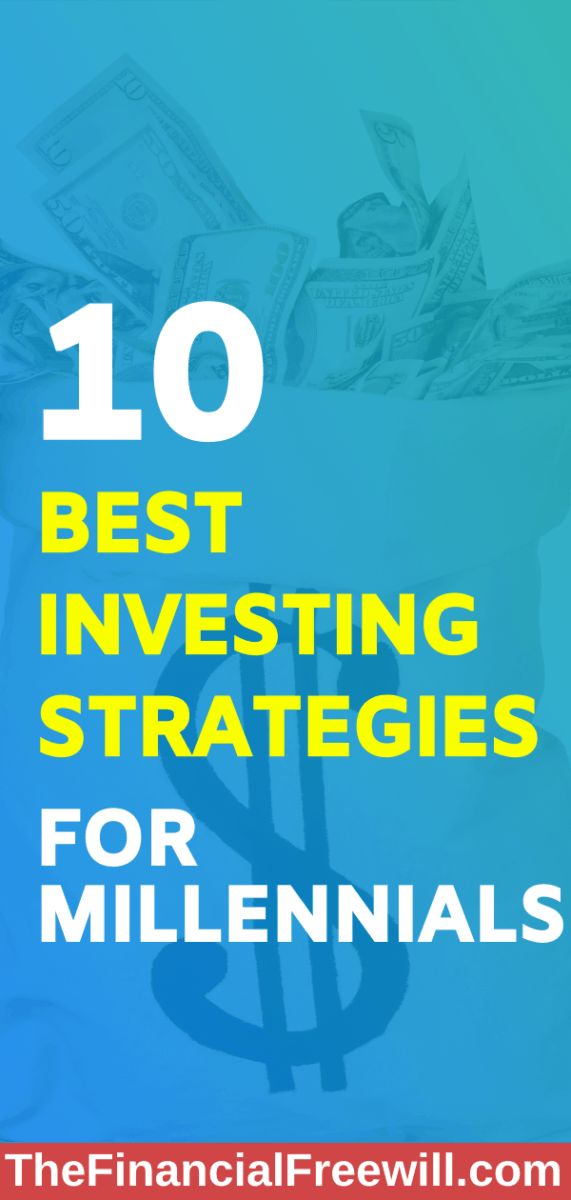This article may contain affiliate links. I might earn a small commission if you make any purchases through my links and it comes at NO cost to you. For more information, please read my Disclaimer page.
So you want to start investing? Great! You’ve come to the right place. Starting to invest when you’re in your 20s and 30s is a great way to build the habit of investing early as well as capitalizing on compound interest.
Here are 10 of the Best Investing Strategies for Millennials:
1) Payoff your debt before investing
This is one of the critical investing strategies for millennials. Before you get too excited about investing it’s important to take stock of your overall financial situation. If your financial situation includes debt, especially high-interest debt, you should consider paying it off before investing.
If you’re having trouble not using and paying off your credit cards in full each month, then your money is better spent taking care of your debt before you start investing. The last thing you want is to be worried about making payments on your credit cards or other debt because you’ve tied up cash in the stock market.
If you end up needing to take money out of your investments prematurely to pay off debt, you’ll end up paying a fee to withdraw the funds.
2) Understand the power of compounding
If you’re new to investing then you may be unaware of the power of compound interest. Compound interest simply put is when your money makes more money.
Compounding, as it is commonly referred to, is when you invest money and the interest you make on the investment also gains interest. While it may not seem like much at first, compound interest can really add up over time. For example, if you invest $100 today and earn 5% interest on it over the course of a year, you would have $105 at the end of year one.
Then if you earn 5% on that $105 you’d have $110.25 at the end of year two. Even if you never add another dollar into this investment, it will continue growing exponentially thanks to the power of compound interest.
FREE Emergency Fund Tracker!
Life is full of surprises, so why not build an emergency fund that can help you when you need it the most. Learn how to build a $1,000 fund in 77 days.
3) Identify your risk appetite
This is one of the popular investing strategies for millennials. When determining where to invest money, it’s important to identify your risk appetite so that you can adequately choose investments that suit your objectives and comfort level.
Ask yourself a few questions to determine how much risk you’re willing to take:
- When will I need to access this money?
- Is this investment for the long term?
- What is the purpose of this investment?
- Am I hoping to use this money to buy a home or other large purchase within the next few years?
- Am I able to ride out the highs and lows of the stock market?
If you know you’ll want to access the investment money within the next few years or if the thought of “losing” money in the market makes you ill, then consider a less risky approach than an all stocks portfolio.
You can invest in a combination of stocks and bonds or just bonds if you’re really uncomfortable with risk or know you’ll need the money within the next few years.

4) Develop a long-term investment strategy
One of the best investing strategies for millennials is to build a portfolio with a long-term strategy. At some point, you may want to put the extra money you have in your savings account into the stock market to earn more than your savings account gives you.
While this is an OK strategy, it’s important to understand that any money you invest in the stock market has the potential to lose its value during a downturn. If you know you’ll need the money within the next few years it may be a smarter idea to keep the money in a savings account or find a high yield savings account.
Investing can be very rewarding if you’re able to develop a long-term investment strategy. If you can withstand the up and downs then historically the market has always recovered after a big crash, and if you keep your money invested you can reap the benefits over time.
FREE Emergency Fund Tracker!
Life is full of surprises, so why not build an emergency fund that can help you when you need it the most. Learn how to build a $1,000 fund in 77 days.
5) Earmark funds for investing
This is one of the smart investing strategies for millennials. Just as it is important to pay off debt before investing, it’s equally as important to take into account the money you’ll be setting aside for investing.
Whether it is money that will be taken out of your paycheck before you receive it, as with an employer-sponsored retirement plan or money you will transfer from your checking or savings account to an investment account, make sure that it’s built into your budget.
If you don’t designate funds for investing you may not have enough to pay bills. This could result in getting yourself into credit card debt because you’ve failed to take into account how much less your disposable income will be each month.
6) Keep your emotions out of the door
There’s one thing you should know if you’re interested in investing for beginners: it’s going to be a rollercoaster ride. There will be highs, and there will be lows.
One day you may feel so excited about your investments yet the next you may be ready to pull out all of your money. The key to success is to stick with it, no matter what is going on in the markets.
If you can keep your emotions in check and not make any rash decisions when the market is tanking, you’ll end up with more success in the long run.
7) Drive decisions based on numbers and fundamentals
This is one of the prudent investing strategies for millennials. There are lots of different types of investments for beginners to consider, and investing fads tend to come and go. Bitcoin and other cryptocurrencies have had their moment in the spotlight, and the Covid-19 pandemic brought new companies to the forefront and increased the number of individual investors.
Remember to base your investment decisions on facts and fundamentals rather than get pulled in by the hype of the media and invest on a whim. There are some basic fundamentals to follow:
- Invest for the long term – Make sure that the money you are investing can stay invested in order to reduce your risk of having to sell out while the market is down. The longer you keep your money invested, the more it will grow.
- Understand the fees you’re paying – If you decide to invest through a financial professional, such as a Financial Planner, make sure you understand ALL fees associated with your investments. These could be fees the professional charges to manage your account, as well as underlying fees in the accounts and investments themselves. To reduce fees, consider opening up your own accounts and choosing low-cost index funds.
- Don’t try to time the market – If you’re trying to “get lucky” by waiting for the market to drop you may lose out. First, if you continue waiting you may always find an excuse to not jump in and get started. Second, the longer you wait, the longer you’ll miss out on the magic of compound interest. Time in the market is more important than timing the market.

8) Do NOT follow others’ investing strategies – Invest in what you understand
When you’re ready to start investing, you may start talking to your family, friends, or coworkers about the stock market. They will likely have their own tips and suggestions as to what or how to invest.
Don’t fall into the hype of others’ ideas before conducting your own research. Your friend, coworker, or family member may have a financial professional they recommend you use, but that person likely will charge higher fees than if you were to manage your investments on your own.
They will also likely put you into actively managed accounts, meaning higher fees for the opportunity to try and “beat the market”. If you’re unsure of what this means, conduct your own research on the pros and cons of passive index funds vs. actively managed funds.
9) Consistently learn & improve your investing knowledge base
It goes without saying that there is a lot to know about investing. I would recommend getting started before you get too overwhelmed with all of the data, strategies, statistics, and different options.
What you choose today is not as important as getting into the market and watching your money grow. Do not worry about making mistakes. Over time, you will continue to learn more and avoid the mistakes you made initially.
There’s always new information coming out about investing, and so continuing to learn and improve your investing knowledge will happen over time if you stay open-minded and curious.
FREE Emergency Fund Tracker!
Life is full of surprises, so why not build an emergency fund that can help you when you need it the most. Learn how to build a $1,000 fund in 77 days.
10) Make investing in 401(K) your top priority
One of the most common investing strategies for millennials is to invest in 401(k). At this point, you may still be wondering where to invest money. Start investing in your 401(k) or another employer-sponsored retirement plan as soon as you can (if you have one).
Most employers will offer a match, meaning they will put in some of their own money if you put in some of yours. Usually, you have to invest a certain percentage of your income in order to qualify for a match, but you can figure this out for sure by referencing your benefits packet or talking to an HR representative at your company. You don’t want to miss out as this is free money!
By electing to contribute to your 401(k) you’ll be investing pre-tax dollars before you can get your hands on them. You will have to pay taxes on these investments eventually, but you’ll be reducing your taxable income in the present and the thought is that when you do need to take these dollars out in retirement, you’ll be in a lower tax bracket.
When you’re looking at investing in your 401(k) know that you will have to pay a fee if you plan to withdraw the funds before the age of 59 ½, except for a few circumstances. Thus you’ll want to make sure that the amount you elect to contribute can fit into your budget in order to prevent running short on cash. The last thing you want to do is sell out of investments or rack up debt to make ends meet.
Other investments
Regarding other investments, make sure you understand what you’re investing in and the fees associated with those investments. You should have options for index funds or target-date retirement funds, which tend to carry lower fees.
If you’re overwhelmed with options you can opt to go with a target-date retirement fund, where you choose which date you want to retire and the fund automatically adjusts your investments to be less risky as you move closer to retirement. You can always change your selection in the future and it’s better to get started than to overthink and miss out on time invested in the market.
And finally, the maximum you can contribute to your 401(k) is $19,500 before the age of 50. If you’re unable to fully fund your 401(k) right away, increase the amount you invest each year until you reach the maximum amount.
Wrap up
Whether you decide to invest through a financial professional, robo-advisor, or take the DIY approach, getting started and sticking with it through the ups and downs of the market will help you reach your financial goals through investing. Just be sure that you have a good idea of where your money is going and get a handle on your debt before you jump in.
If you want to be successful at investing, the key is to start as early as possible. Once you build the momentum, continue to improve your knowledge and the amount invested.
What has your experience been? How did you start investing? Please share your experiences, thoughts, tips, and ask away any questions in the comment section below!


These are such great tips! Our younger generation needs to read this and take it seriously. Thanks for sharing!
Thanks Tobie!
Great tips. Would love to know a step by step guide on setting up compounding through investments. I currently use STASH and I like it but I’m very much a newb!
Thanks Tabitha! Compounding can be achieved by investing in mutual funds, etfs and money market accounts (to name a few options) where you can automatically reinvest the gains on investment to earn a higher return.
Great insights. Thanks for sharing!
Thanks Can!